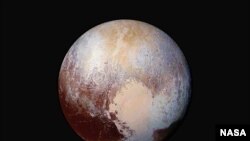While all eyes are focused on the Juno space probe’s historic encounter with Jupiter, NASA has announced it is extending the mission of the New Horizons spacecraft, which recently provided dazzling photos and information on the dwarf planet Pluto.
New Horizons will be heading further into the the Kuiper Belt, a region of the solar system that contains asteroids, comets and other small bodies, to rendezvous with an “ancient object” called 2014 MU69, which the space agency calls “one of the early building blocks of the solar system.
The probe is expected to arrive at 2014 MU69 on January 1, 2019.
“The New Horizons mission to Pluto exceeded our expectations, and even today the data from the spacecraft continue to surprise,” said NASA’s Director of Planetary Science Jim Green. “We’re excited to continue onward into the dark depths of the outer solar system to a science target that wasn’t even discovered when the spacecraft launched.”
NASA also said it was keeping the Dawn spacecraft in orbit around the dwarf planet Ceres rather than heading to the asteroid Adeona.
“The long-term monitoring of Ceres, particularly as it gets closer to perihelion, the part of its orbit with the shortest distance to the sun, has the potential to provide more significant science discoveries than a flyby of Adeona,” said Green.
New Horizons, the first probe to visit Pluto, was launched in January of 2006, while Dawn was launched in September of 2007.









